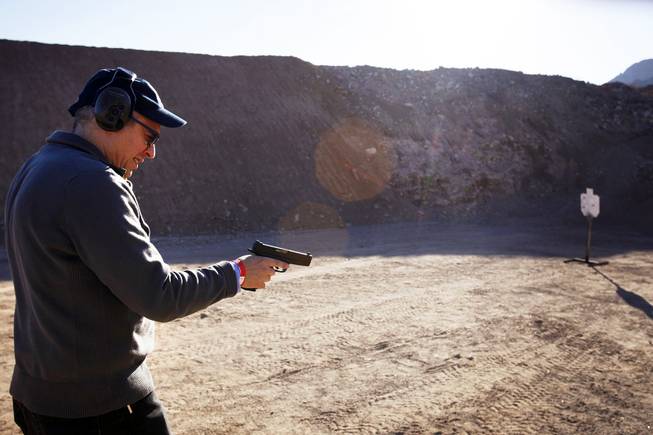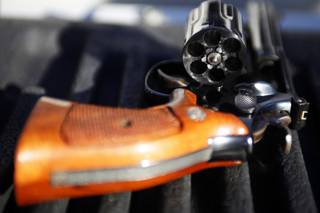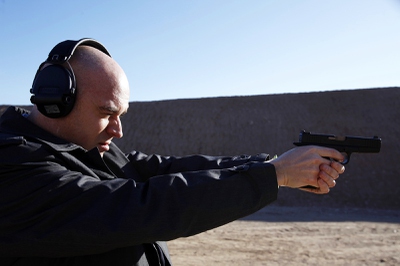
Paul Barrett shoots a Glock at Desert Hills Shooting Club in Boulder City on Monday, Jan. 16, 2012.
Tuesday, Jan. 17, 2012 | 2 a.m.
Sun archives
- In spite of recession, gun business taking off (01-20-2011)
- 2011 SHOT show (01-09-2011)
- More columns by J. Patrick Coolican
We’re at Desert Hills Shooting Club near Boulder City, and Paul Barrett steps up with a Glock 17. He fires the 9 mm semi-automatic pistol 18 times in about five seconds and hits the target every time.
In that five seconds, he demonstrates why the Glock is beloved by gun enthusiasts and police officers alike. It’s fast, reliable and offers a lot of stopping power, with three times the number of rounds as the old police favorite, the Smith & Wesson .38 revolver.
Barrett, in town this week for the Shooting, Hunting, Outdoor Trade Show (SHOT), the big firearms convention, has just published “Glock: The Rise of America’s Gun,” an entertaining and informative history — even if you’re not a gun enthusiast — of the firearm company that redefined the American handgun market beginning in the 1980s.
Like many business success stories,Glock’s involves ingenuity, but also dumb luck.
Gaston Glock managed an auto parts factory, with a side business making brass fittings, field knives and bayonets. As the story goes, Glock was at the Austrian Ministry of Defense on bayonet business and overheard a conversation about the Army needing a new sidearm.
Glock, who had almost no experience with guns, acted as a general contractor, bringing together experts to design his weapon. Its genius is its simplicity — the Glock has half, and in some cases one-third, the number of parts of similar handguns. It has no external safety lever and, as Barrett puts it, a “light, steady trigger pull.” (As Barrett also notes, ease of use also means it’s easy to misuse.)
He compares the Austrian gun to the reliable, efficient foreign cars that Americans adopted en masse beginning in the 1970s, while American auto and gun makers floundered, mired in their own arrogance.
Here’s where luck comes in: Around the time Glock was developing his gun, American crime was spiking, and high-profile gun battles between police and criminals were common, with law enforcement often outgunned. Barrett points to a disastrous confrontation between the FBI and two criminals with massive firepower that ended with two dead agents, three permanently disabled and two more injured.
Glock was a great vendor for police departments because the company would take old revolvers in trade and offer free training on the new pistol.
Once police adopted the Glock, Hollywood followed. By now, as Barrett said, a Hollywood script will no longer say “semi-automatic pistol.” It will say merely “Glock.”
The Glock also captivated the hip-hop world. Tupac: “I chose droppin’ the cop. I got me a Glock.” It’s an easy rhyming word. And let’s face it, Glock is just a great name for a gun.
A final piece of good luck: Gun control advocates — when there was such a thing — called out the Glock by name. The journalist Jack Anderson wrote an apocryphal story about how the Glock was passing through airport X-rays undetected. As Barrett said, there’s no better way to juice sales of a firearm than to tell gun enthusiasts they can’t have it.
After losing Congress in 1994 and the White House in 2000, in part because of the gun control issue, Democrats dropped it, leading to a golden age of gun rights perfectly timed with the rise of Glock.
You may not believe this, but I’m not much of a gun person, not having shot a firearm in more than a decade. (Yes, I lose all right to call myself a Nevadan.)
After some safety training, I took the Glock in hand and stepped up at Desert Hills Shooting Club. The trigger is so light the first shot is startling, though I hit the target. After that I settled down a bit, but there’s no question firing it sends adrenaline coursing through you like you just drank a pot of coffee. I got a sense of how difficult it is to hit a target, even at close range. Imagine the target shooting back.
Cameron Hopkins, a Henderson resident who is editorial director of Combat Tactics magazine and author of the NRA’s Industry Insider blog, explained the difference between the Glock and a Smith & Wesson .38 revolver, which is what 95 percent of police agencies used before the Glock.
He shot the Glock 18 times in about 5.5 seconds. To do the same with the six-shooter, he took nearly 24 seconds because he had to reload. He hit the target every time with both.
Barrett’s book closes with intrigue and turmoil at Glock, which is privately held. Gaston Glock is 82 with a new wife half a century his junior, an angry ex-wife and adult children, and former senior management charged with financial improprieties.
After 7 million units sold, the future of the Glock is a bit uncertain, though its place in history is secure. As Barrett said: “It’s not the romantic idea of a gun. It’s the essence of a gun.”



Join the Discussion:
Check this out for a full explanation of our conversion to the LiveFyre commenting system and instructions on how to sign up for an account.
Full comments policy